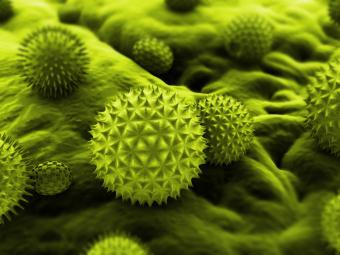Definition of Pollination

Pollination makes life on earth possible, as it underlies the reproductive process of 80 percent of the world's flowering plants. It is simply the transfer of microscopic pollen grains (pictured here) from the anthers of a flower, the male sexual organ, to the stigmas, the female sexual organs of flowers. If pollination is succesful, seeds are formed in the flower's ovules, allowing the cycle of life to continue.
Importance to Gardeners

Without pollination there are no fruits or seeds, making it a subject of great importance to gardeners. For example, corn, a wind-pollinated plant, is more easily pollinated if it is planted in blocks of three or four short rows, rather than one long row, resulting in fuller ears and fatter kernels.
Understanding pollination is also relevant for saving seed from some plants. If you want to save seed from particular variety of squash, for example, you have to isolate the flowers (usually by enclosing them in a plastic bag) to prevent pollen from another squash variety from drifting in that would result in hybrid squash seed that produced squash differed from either of its parents.
Self- and Cross-Pollination

Some species self-pollinate, meaning their pollen is capable of fertilizing the flowers from the same plant. The advantage of self-pollination is that you only need one of a particular plant to produce seeds or fruit, though it will still be reliant on a pollinator to do the job.
Other plants require cross-pollination, where only pollen from another individual of the same species can pollinate the flowers. Cross-pollination helps to maintain genetic vigor by introducing slight variations in the gene pool in each generation of new plants from a given population.
Crossing Produces Good Crops

Most annual vegetables are self-pollinating, but cross-pollination is important for many fruiting trees and shrubs, which means you have to plant two or more distinct varieties of the same species to produce a good crop of fruit.
Most varieties of apples, pears, cherries and blueberries require cross-pollination, while peaches, plums, apricots, grapes, blackberries and raspberries are generally self-fertile, an alternative term for self-pollinating that means the variety will produce fruit without a partner nearby.
Bee and Insect Pollination

Many plants are reliant on bees and other flying insects to achieve pollination. They use bright colors and sweet fragrances to attract the pollinators, who are rewarded with a drink of nectar. In the process, the insects brush up against the anthers, collecting pollen grains on their bodies and transferring it to the stigmas. Though honeybees are the most famous pollinators, wasps do pollinate, along with flies and a myriad of others that seek the food provided by flowers, inadvertently performing pollination in the process.
Pollination by Hummingbird

Hummingbirds are yet another agent of pollination for the plant world. They are particularly attracted to flowers with warm color tones and a long tubular shape, which their extended beaks have evolved to probe for nectar.
Wind Spreads Pollen

Other plants rely on the wind to spread their pollen, rather than insects. These plants rarely have showy or fragrant flowers because they don't have to attract pollinators. They do have large quantites of pollen, though, and are the species that cause humans to suffer from pollen allergies, such as grasses and pine trees.
Hand Pollination

People can be pollinators, too. In some cases, such as growing tropical fruits like cherimoya, farmers and gardeners routinely hand-pollinate the crop, because the specialized insects that pollinate these fruits in their native habitats are not present in North America.
Sign up for our newsletter featuring all the latest stories and products we love.
Fertilization Is After Pollination

When pollen grains land on the sticky surface of the stigma, they trigger the development of a pollen tube, which opens inside the stigma and allows the pollen to descend through the pistil and into the ovule. Here it fuses with the ovule to develop an embryo - the process of fertilization - which becomes a seed. Without fertilization, there would be no fruit, as this is the fleshy, sweet-flavored tissue that forms around the seeds of some plants.
Species That Attract Pollinators

Pollinators are important for the regeneration of plant communities and for growing food plants in particular, so many gardeners plant species that are known to attract large numbers of these and other beneficial insects. Such plantings are often referred to as insectaries and can include any nectar-rich species with a long bloom period - clover, rosemary, lavender, and anise hyssop are common examples.
Understanding pollination is one of the keys to unlocking the mysteries of the plant kingdom and growing a more bountiful garden. By planting the flowers that pollinators love, you ensure the presence of life-giving pollinators and can enjoy the same flowering species that they rely on for nectar.







